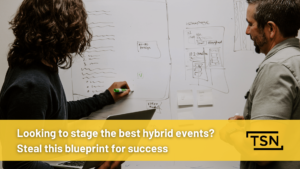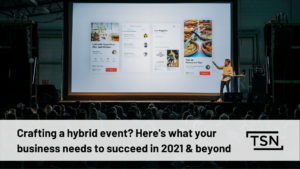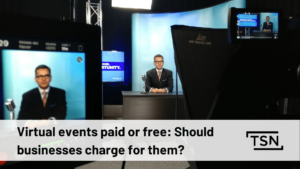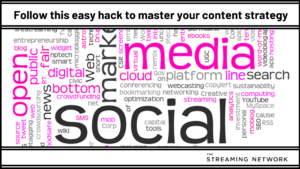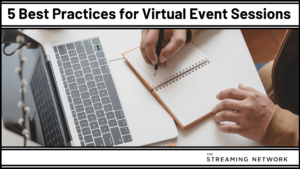Podcast: Play in new window | Download | Embed
Subscribe: Apple Podcasts | Google Podcasts | RSS
Lessons From The Frontline: How I Learned to Live with Never Getting a Second Chance with Live Virtual Events – Part 1
It’s been a while, but we are excited to announce that we are bringing back our popular video podcast series, or vodcast, Lessons From The Frontline.
In our last episode, we talked about the rapid growth of webinars and their place in the marketing industry.
Virtual events and real-time interaction had become the gold standard. Successful brands leveraged these tools to reach their customers around the clock and created an ideal opportunity to use webinars.
For our latest episode, we dive into the world of professional development, specifically focusing on financial services and continuing education.
Unless you take care of your own investments, most individuals work with their financial advisors. Essentially, they are selling us a product manufactured by another company. In order to understand what they are selling to you, it’s imperative that financial advisors maintain some form of education about their industry.
Fund manufactures found that leveraging webinars was an effective method of delivering product information and services, but more importantly, accredited content.
In our seventh episode, we are discussing:
- The need for a hub that hosts Continuing Education (CE) Webinars and CE management.
- The Netflix effect and how that translates to a higher viewership rate.
- Streamline your administrative process by accessing CE credit history whenever and improving the financial advisor experience.
The Complete Video Transcript
Peter Vamos: Webinars are hot. As a content marketing professional, I produce hundreds of videos for social and traditional media platforms and currently work with one of the largest podcast networks in the country. So, for me, understanding how webinars work in the B2B space is both essential to my professional development and an exciting form of content creation.
According to a study commissioned by Digital Agency Demand Wave, 41% of B2B marketers cite webinars as the best marketing tactic for driving revenue. I’ve set out to discuss webinars with one of the foremost experts in the field, Matt Ley, President of The Streaming Network in Toronto.
Together we’ve created this multipart series of videos and podcasts, The Webinar: Lessons from the Front Line or How I Learned to Live with Never Getting a Second Chance with Live Virtual Events.
Peter Vamos: Welcome back to the webinar Lessons from the Front Line. With me, as usual, is Matthew Ley, President of The Streaming Network, Canada’s premier webinar services provider and, safe to say, one of the foremost experts in this field.
Matt, following our first series of podcasts, we got a lot of marketers and webinar producers looking for industry-specific data. Many also said that won’t work for my industry or those must be US stats. So, we heard a lot of naysayers, too.
Matthew Ley: How funny that’s what you heard because what I heard was, was that Pete’s basement we were in for the first one and I’d say no, this was a very interesting new set that the guys built down at the studio for this podcast series.
And then the other thing that I heard a lot about is was when I got convinced to put my sunglasses on in the last episode for the future and how that might not have been the best idea for my personal brand, but, I’m glad that you at least got some real feedback on the content.
Peter Vamos: I got some real information. By the way, we are now actually in my basement. No, we got some great feedback on that, and what we wanted to do is sort of breakdown the sectors because what we were talking about last time was very general. So, we thought it would be interesting to actually go sector by sector and we’re going to focus this time on–.
Matthew Ley: Financial services.
Peter Vamos: Financial services.
Matthew Ley: Yeah.
Peter Vamos: Some interesting statistics coming out of financial services sector. There’s 780,000 jobs and it represents 6.8% of the Canadian GDP which is quite significant. We are playing in a big market here.
Matthew Ley: Yeah, and most of those headquarters are right here in Toronto, Ontario.
Peter Vamos: That’s right.
Matthew Ley: Yeah, that’s where we see a lot of it.
Peter Vamos: So, the financial sector has become the bedrock of The Streaming Networks’ business. Can we talk a little bit about that? In the last 12 months, we have seen some significant growth.
Matthew Ley: Yeah, yeah. Of all of the programs that we’ve launched over the last 12 months, I would say the largest ones have been in financial services, which is interesting because they were early adopters. Right?
Most of our business is centered around the wealth management space. So you and I, we invest in mutual funds or whatever we might do, and we’ll have a financial advisor who speaks to us. That financial advisor is the person who’s basically selling us a product that another company manufactures. And so it’s interesting that a lot of financial services are B2C. Right? We all have bank accounts. We all buy insurance products, mutual fund products.
But in this case, they’re applying a B2B model to get to us, going through that advisor who may be part of a large company or an independent. And so, years ago when it became necessary for these advisers to maintain a certain level of education every year, the fund manufacturers at the time had to find a way of reaching these advisors. And so they found that the webinar was an effective way of delivering information on their products and services, but more importantly, accredited content.
And so, from that point, the webinar if you will, become a staple or it was a bedrock of their business. And we’ve always serviced them from day one we’ve always had customers in this space but it’s just over the last few years that we’ve seen the needs of the space really grow and hence why they have been such a growth sector for us.
Peter Vamos: Right. So, let’s dig into that a little bit. In terms of it is a very different sector from the other businesses that you guys deal with. Let’s talk a little bit about that. I mean it’s a big player obviously we talked about that but what are some of the other differences?
Matthew Ley: I look at it almost like it’s a distribution play. These advisers, quite often, will work with multiple different manufacturers of products. So they will work with a BMO Global Asset Management as well as a McKenzie Financial, something like that.
And so, the marketers are putting this content in front of them, but it’s not necessarily or in the past, has not been a situation where they are looking at these advisers as MQLs or SQLs or if the person – at our last webinar series we talked about if someone asked three questions, downloads two resources– if they’re taking a lot of action they are likely interested in your product or service.
They weren’t looking at it that way and not necessarily having a follow-up process that followed through the webinar. They knew why the people were coming and that was usually to get a credit. So, it’s different than other sectors in that, it doesn’t apply that standard or was not applying that standard B2B sales process across it.
Another reason is that it is a regulated industry highly and with CASL legislation and with the way some advisory firms are set up, data is not what it is in the business world.
We hear things about advisory firms where they use one email address for everyone. We hear stories about not being allowed to communicate in certain ways with certain groups because they don’t want that to happen. And so, the marketers have their hands full.
In one hand they have this great way of getting people to the dance. Offering them a CE credit that they need, and on the other hand they have their hands cuffed because they don’t have these big sales teams or this process in place that a company like The Streaming Network might have to really action what they see from a webinar. And as such, I think that what we saw for many years was a stagnant market.
People wanted– people looked at webinars in the financial services space or at least in the advisory space as table steaks. We heard this all of the time. It just has to work, that’s it. As long as we can hear the presenter, the slides go out, they get their credit, nothing else matters. And over the last 12 months, there has been a genesis of wanting more out of the program.
We reach these advisers this way, thousands of them every year or some of them multiple times or whatever it might be. We need to provide more to them in this medium and it’s been a fun ride the last 12 months.
Peter Vamos: Great. So, let’s talk a little bit about how they actually compare to other businesses that you work with in terms of– because there’s a lot of differences but then we’re also seeing a lot of similarities, aren’t we?
Matthew Ley: Yeah, and that’s why at one point last time I did the card trick trying to show that some things just always work out and there are trends that are happening that were driven by, not by us in B2B, not in the business world. They were driven by what we’re doing at home, and those trends are true in conventional if you want to call it that, B2B webinar programs like mine or a technology company as they are financial services.
So, across the many customers that we service, and we have a large group of them as mentioned, we are seeing increased usage within the same customers. So, customers who maybe had a standard program that had, I don’t know, 10 bilingual webinars a year or whatever it is, most of them if not all of them now we are seeing more of those events happening. And on the flipside, we are seeing a higher viewership across those events particularly within on-demand.
So, advisers are real people. I always say that about everyone’s customer, they are normal people. At home they are consuming more video online, they’re on the Internet more, they’re on their phones.
They are using services like Netflix and binge-watching content and those practices carry over into their business lives because they are the same person and so higher on-demand viewership was a big theme of last year.
We saw the number, the percentage of viewers increase and most importantly the amount of time they stay on a webinar increase. In financial services you have to stay to the end to get your credit, they have great retention in on-demand and those numbers are really growing.
Another stat that we referenced before which has held true within financial services is increased use of video. In all aspects whether it be producing video, short format video for the website that goes into the webinar, doing video webinars for certain segments of their audience who they think that will resonate better with, or it’s basically using the video medium to expand the reach of a physical event or something like that.
And then finally we are starting to see a modernization in the way they look at their customer, actually looking at the advisor as a prospect or probably not so much a prospect but an opportunity for expansion.
And so wherefore maybe the year before or the year before that, I’ve been at this a long time I don’t remember, and we have a financial services team here that goes out but sometimes I’m brought into the meetings, is I would talk about all of the awesome actionable data that we had. I’d be like we can do this, and we can do that, the stuff that was getting to every other marketer really, really excited.
“How do you get that into my CRM?” And a couple of years ago I was hearing from people yeah, “we can’t get that into our CRM, it’s proprietary,” or “that’s going to be a three-year project,” or “you know what, it doesn’t really matter to us as long as it works,” and they get the credit and that all changed.
Nine times out of 10 when I’m out there that’s what we are talking about is how we get the data not even into one system but into multiple systems so that we can have aggregate information, we can action this based around other data we have on people.
And so, it’s interesting to see that change happen and it’s happened everywhere else as well, but to see that change happen and now, it’s fun to figure out what are the levers in this industry that drive revenue versus some of the more conventional industries that we’ve serviced in the past.
Peter Vamos: Right. So, things are changing and yet maintaining the same kind of framework?
Matthew Ley: Yeah, yeah, exactly.
Peter Vamos: Obviously they face challenges within this area so let’s unpack that a little bit. What sorts of challenges are financial services businesses facing right now?
Matthew Ley: I see two big challenges. One of them is flushing, and maybe it’s three. There used to be a challenge I’m seeing flush out in most firms that we walk into which is, legacy disjointed systems. Systems that tracked like, purchase revenue size and systems that tracked advisers and systems that tracked continuing education and none of them really spoke to each other.
A lot of them are homegrown and that made them closed to the public and close to sort of data from trading or whatever it might be, and I’m seeing that flush out across companies. As those products become end of life, they look to like everyone else, look to the cloud, look to new services, those are generally more open.
Change management is challenging. They are a highly regulated industry. We deal in a lot of these and even though everyone at the table thinks everyone knows it makes sense, but going through that change management has to be done very carefully within a financial services firm.
So, I know there’s a lot of people who I’ve spoken to this year who, they want to do more and they’re going to do more but they’ve got to take their steps to kind of get there.
But the real problem that we talk about more than anything and it was the same problem we were talking about four years ago and it’s the same problem we’re talking about today, is the management of this CE or this continuing education.
So, the webinar as I mentioned grew in this space because it helped deliver that to a broad audience, but that still needs to be tracked. That still needs to be given back to the advisers, all kinds of things that go along with it plus the webinar is only one track for the CE, which we found out after we accumulated so many customers in the space was that they are doing a ton of in-person stuff that has CE, they are doing a ton of one-on-one or small group CE.
They might have purchased some content from someone else and that delivers CE and it’s someone’s job and they have to; the regulators demand this way.
A, they have to track all of this for a certain amount of time. I believe it’s two or three years or something like that and then upon request these advisers who are nothing more than sales reps really always asking marketing for content or whatever, they have to track it for them, so they can give them certificates.
I have been in rooms this year where people were talking about mailing these things out. I’ve been in rooms where people are talking about just it’s a full-time job just keeping track of this stuff and we still are struggling with it. Right? So, no matter in of the other problems this is the biggest problem that I think they still face and it’s also presented for us the greatest opportunity.
Peter Vamos: Right. And it’s interesting really these organizations aren’t set up for– I mean they’re set up to help people make money like they are not really set up for this kind of administrative stuff and it must be quite difficult and obviously TSN steps into that void to sort of help them with this thing. In the last 12 months as you have seen things expanding, how has The Streaming Networks’ approach changed?
Matthew Ley: Well, yeah, I think that we looked at this problem and it was a problem that it’s one of those things where you keep hearing the same thing and at first the CE management I was like there’s got to be a tool out there.
Why have these guys not found the tool? And so, unwrapped the onion a little bit more and then you start finding out, there is tools, but they operate for this or like this or like that. And so, one thing that we had done as is we created a platform that is very simple and what it does is it basically pulls in data from our webinar tool first so that advisers can come to this app and basically enter an email address, see all of their credit history.
What that did and download their certificates, whatever they need to do– so what that did is it reduced the burden on the financial services firm we were supporting because they no longer have to email things out, mail or answer queries. They just say, go here and get your history.
So that got off the ground and our flagship customer was BMO Global Asset Management. Things went really well with them and then they said, “we have this other problem over here which is in person.” I’m like we live in a virtual world, we have nothing to do with in person and when we started having those meetings we realized that that problem was even larger.
Guys walking into meeting rooms to get their accredited content and dropping off business cards and that was the record that they had been there. People having paper sign-in sheets across the country, events occurring that, maybe the CE person has created a program that could be delivered out there, but didn’t know every day that it was being delivered and then people were looking for credits afterwards.
So, this became a larger and larger annoyance for them but also made our product a lot less valuable to them, because we were only servicing this virtual audience. So, this year we invested money, time and resources into finding an easy way of ensuring that this product is where all of the data lies, whether you’re on-site you get data in through API or upload. If you are online on our platform it’s automatic and if you’re online on another platform, again, API automatic or upload from that system. But at least now, an advisor or anyone coming in who is taking your courses gets access to everything in one spot, and you have detailed tracking on what everyone is doing.
So, when that got built we got that in place and we got– we had the webinars going and that became a big catalyst for change within companies. This fixed such a big problem, even though if you ever look at it seems like such simple thing and it really is, but such a big problem for them that we started moving on to the next problem and the next problem was data integrity.
Was people having/using personal email addresses versus work email addresses because a lot of these guys are independents and being able to effectively create a profile for someone and pull them through this process of webinars or online training or whatever it is and CE. And so, we started utilizing one of our products that I might have talked about last time, the virtual environment product.
Initially set up for virtual conferences, later adopted by a lot of internal learning and development departments as a virtual learning environment which was a more exciting way of delivering content to your employees than an LMS system, and we skimmed that for basically an advisor experience.
Come in through some level of single sign-on, access all of this great CE content as well as get all of your CE content but because you come in with one profile, it helps fix the data problem.
And so, we went from being this outlier that was delivering some CE in these webinars, thought leadership down too, down to this integrated aspect of these financial services companies getting data from them, passing data back to them and in the end fixing a bunch of problems along the way.
And so, it was—you know, you keep getting asked to do something for someone eventually you figure there some money there, but it’s been fun for me learning about these challenges and we’ve have been able to find some pretty simple solutions for them.
Peter Vamos: Right. And it must be great because the advisers obviously for them it’s a wonderful experience. It is something that cuts down on their travel time. They can focus more on their clients, right?
Matthew Ley: Yeah.
Peter Vamos: And the ability for these companies to gather all of this, have all of this information be in one sort of spot, must be a huge win for them. So, they can just do away and have people doing all kinds of other important tasks. Vacuum up business cards.
Matthew Ley: Those people in those firms are professionals, it’s not like they have—getting temp labor to do this work, right? So, it’s expensive– but think about this too.
You mentioned the advisor experience, making it easier and this has been something that we been hearing a lot, and this is coming up a lot in many, call it mature industries, legal and the pharmaceutical industry dealing with healthcare professionals and in financial services we hear it in almost every meeting.
So, we have to improve that advisor experience and that is because I don’t know if it’s a changing demographic that everyone is facing the younger advisers are now starting to come through or it’s a more competitive landscape I’m not sure, but you’re sitting here and you’re looking at these process flows that made sense five, six, seven years ago and were done because they had to be done.
Websites that are set up with high levels of compliance so that there’s a lot of checks and balances going in there, which means that every other marketer out there is making all of their stuff as easy as possible to access and financial services, unfortunately, was adding all of these layers and the steps.
So, you’ve got an advisor whose even 30 years old now coming into the market. These are the ones that they want, this is the future of their client base, and they are looking at this going are you kidding me?
Peter Vamos: There is a ton of friction, a ton of–.
Matthew Ley: Are you kidding me? This is what I’ve got to do to get my content. And so, improving that advisor experience has always– if we get an RFP or if we walk into the room with the SVP that is one of the top three things that we’re trying, that they’re trying to do with the project that they’re opening with us.
Peter Vamos: And the reaction generally has been very positive obviously with these new products and you’re getting a lot of people coming to using what? They’re saying–.
Matthew Ley: Well, yeah. I mean it’s funny we always say we don’t get a lot of the downstream response from like the advisor or whatever it is, but I think now it’s at a point where we’re simply giving them what they expect to have. You know what I mean? Access to what they want when they want it like the rest of the world in their personal life.
But in general, you know, we’re hearing from our customers just in that reduction in time, we’ve got some case studies about it, about that the cool thing is that I felt like it was a bit of a stagnant market for us.
We were delivering the same thing over and over again and now we go into meetings like, “can we do this, can we do that?” because now that we have this basis of success like what else can we do? They’re starting to really get, starting to think which is a lot of fun.
Peter Vamos: That’s amazing. Well, that’s all the time that we have. Mom is calling me up for dinner, it’s lasagna night.
Matthew Ley: That sounds good. I think I said webinar less time and whatever that was 20 or 30 minutes than I have any time I’ve been on camera.
Peter Vamos: Well, we’re going to rectify that in the next webinar.
Matthew Ley: Fair enough.
Peter Vamos: Until then thank you very much, Matt, for coming down to the basement and enjoying this time with me and we’ll see you again.
Matthew Ley: Sounds good.
Peter Vamos: Good.

